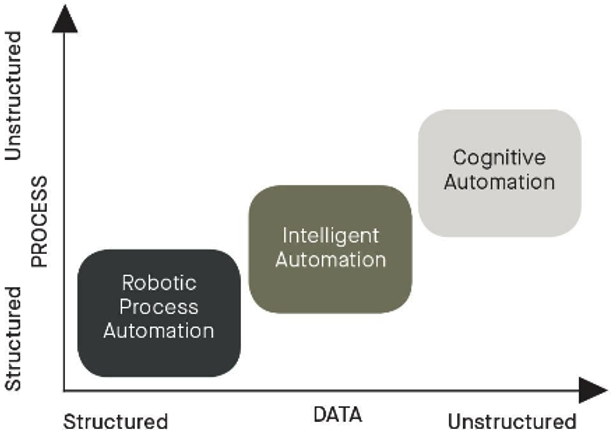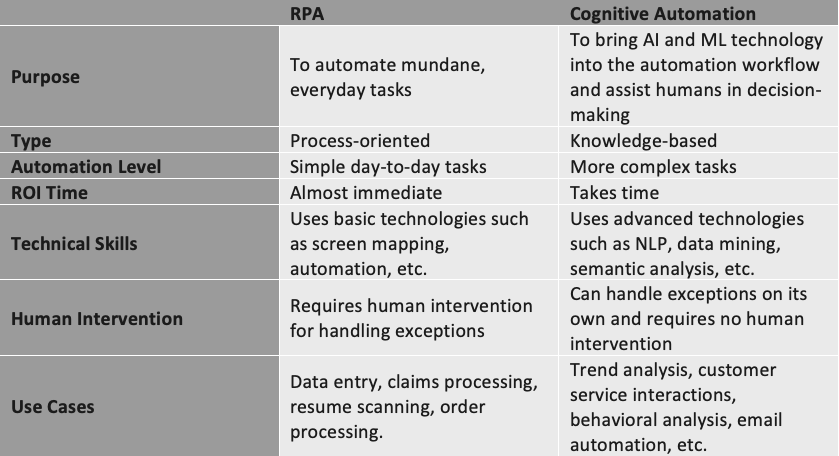
RPA vs Cognitive Automation: What You Need to Know

The use of Robotic Process Automation (RPA) in enterprise applications has risen rapidly in recent years due to its many benefits: automating tasks, streamlining processes and reducing cost. Just as RPA adoption is increasing, so too is cognitive automation, but what are the differences between these two technologies? How, and when, should they be deployed?
RPA is a tool that automates routine, repetitive tasks which are ordinarily carried out by skilled workers. RPA relies on basic technologies, such as screen scraping, macro scripts and workflow automation. RPA performs tasks with more precision and accuracy by using software robots. But, when there is complex data involved, it can be very challenging and may ask for human intervention. This is where cognitive automation comes in.
Cognitive automation promises to pick up where RPA stops. It is a tool which brings intelligence to information-driven processes and often also known as intelligent process automation. Cognitive automation is a subset of artificial intelligence that uses advanced technologies like natural language processing, image recognition, pattern recognition, data mining, and cognitive reasoning to emulate human intelligence. In simple words, cognitive automation uses technology to solve problems with human-like intelligence. Smart work like extracting information from unstructured data and deriving meaningful conclusions is cognitive automation.

RPA challenges
There are many benefits to RPA when it comes to automating relatively simple, process-oriented tasks, but as enterprises increasingly adopt RPA in different scenarios, they’re also increasingly faced with its limitations.
- RPA is usually a short term/interim solution – It can provide an immediate relief and benefit, but in the long term, it requires complex omni-channel platforms and frequent workflow review and optimization.
- Current RPA tools available in the market have no or limited machine learning capability – We’re still quite far away from the moment when automation will be truly cognitive. The scope for automation will increase exponentially with AI and machine capability getting integrated with RPA tools, but we are not there yet.
- Limited application – This may involve handwritten documents. Partial automation based on cost and benefit analysis can be considered if full end to end automation is not available or attainable within reasonable timescale.
- Change management – Business and IT teams need to collaborate and proactively provide system and business updates to the RPA support team to update scripts, once they are in the production.
How cognitive automation overcomes RPA challenges
Many of the biggest enterprise challenges today are to do with the way businesses can increase efficiency, reduce operating costs and improve decision-making. Cognitive automation improves the efficiency and quality of auto-generated responses. Here’s why it is the next big step for automation operations.
- Cost-effectiveness – Cognitive automation can help to reduce process time by approximately 40%.
- Operational efficiency – As well as reducing cost, cognitive automation enhances productivity.
- Accuracy – It reduces human-based errors.
- Expert decision-making – Unlike RPA, which speeds up and automates simpler processes, cognitive automation combines AI and automation technologies to be able to make decisions that lead to better outcomes.

Choosing the right automation technology
RPA and cognitive automation may often be grouped together because they help automate business processes, however they’re not either / or technologies. Rather, the choice to use cognitive automation or RPA will depend on the nature of your process. If your process involves structured, voluminous data and is strictly rules-based, then RPA would be the right solution. However, if you deal with complex, unstructured data that requires human intervention, then cognitive automation would be more apt for your organization.
While RPA provides immediate ROI, cognitive automation often takes more time as it involves learning the human behavior and language to interpret and automate the data. However, if your process is a combination of simple tasks and requires human intervention, then you can opt for a combination of RPA and cognitive automation.
The best way to develop a solution that works for your organization is by partnering with a Digital Engineering Specialist who understands the evolution from RPA to cognitive automation. Apexon has extensive experience of combining the two technologies, fortifying RPA tools with cognitive automation to provide end-to-end automation solutions.
To find out how Apexon can help you realize the full benefits of Automation, get in touch today using the section below.